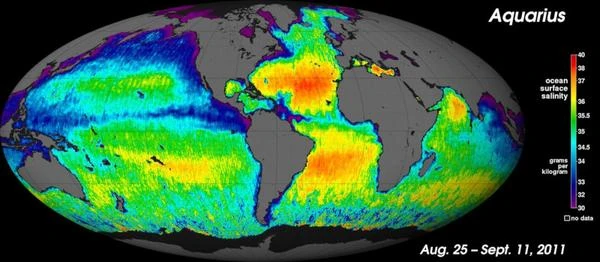
The surface salinity of the oceans plays a crucial role in global ocean dynamics. It influences water density, conditions thermohaline circulation, and interacts with the water cycle and atmospheric-ocean heat exchanges. A variation in salinity can reveal large-scale climatic processes, such as El Niño or seasonal shifts in the Gulf Stream. However, until 2011, measurements were primarily point-based or derived from models. The launch of the Aquarius satellite, designed by NASA and the Argentine CONAE, revolutionized this field by enabling direct and regular spatial observation of salinity on a global scale.
Aquarius was equipped with a passive radiometer operating at 1.413 GHz (L-band), sensitive to small variations in the emissivity of surface waters induced by their salt content. To correct for atmospheric disturbances and surface effects (wind, temperature, roughness), the satellite also carried an active L-band radar (scatterometer). The quasi-polar orbit of 657 km allowed for global coverage in 7 days with a spatial resolution of approximately 150 km. The salinity measurements thus obtained had a precision of about 0.2 PSU (Practical Salinity Unit), sufficient to detect significant regional anomalies.
During its 4 years of activity (from June 2011 to June 2015), Aquarius provided monthly global maps of surface salinity that allowed for:
In June 2015, an electrical failure ended the mission. However, the collected data remains a reference, particularly for ocean-atmosphere coupling and the calibration of successor satellites such as SMOS (ESA) and SMAP (NASA).
Aquarius demonstrated that salinity could be reliably measured from space. Its success paved the way for a new discipline: space hydro-climatology. Aquarius data, freely accessible, continues to fuel studies on global hydrological balances, ocean acidification, and climate variability. By combining temperature, salinity, and altimetry (for example with Jason-3), researchers now have consistent tools to understand energy fluxes in the global ocean.
| Satellite | Agency(s) | Period | Main Parameter | Technology Used | Resolution / Precision |
|---|---|---|---|---|---|
| Aquarius | NASA / CONAE | 2011–2015 | Surface Salinity | L-band Radiometer + Scatterometer | 150 km / ±0.2 PSU |
| SMOS | ESA / CNES | 2009–present | Salinity & Soil Moisture | L-band Microwave Interferometry | 50 km / ±0.2 PSU |
| SMAP | NASA | 2015–present | Soil Moisture + Salinity | Passive Radiometer + Radar (defunct) | ~60 km / ±0.2 PSU |
| Jason-3 | CNES / NASA / EUMETSAT / NOAA | 2016–present | Sea Height (Altimetry) | Ku/C Radar Altimeter | ~10 cm altimetric precision |